|
|
 |
|
Cyclopoida ( Order ) |
|
|
|
Corycaeidae ( Family ) |
|
|
|
Corycaeus ( Genus ) |
|
|
|
Urocorycaeus ( Sub-Genus ) |
|
|
| |
Corycaeus (Urocorycaeus) lautus Dana, 1849 (F,M) | |
| | | | | | | Syn.: | Mimocorycella Pestai Rose, 1929 (p.74, figs.F,M, Rem.);
Corycaeus lautus : Corral Estrada & Pereiro Muñoz, 1974 (tab.I);
Urocorycaeus lautus : Gaudy, 1963 (p.33, Rem.); Dessier, 1983 (p.89, Tableau 1, Rem., %); Dessier, 1988 (tabl.1); Boxshall & Halsey, 2004 (p.493); Pagano, 2009 (p.116); Vives & Shmeleva, 2010 (p.243, figs.F,M, Rem.); Rojas-Herrera & al., 2016 (p.40, Table 2: temporal abundance); Marques-Rojas & Zoppi de Roa, 2017 (p.495, Table 1); Acha & al., 2020 (p.1, Table 3: occurrence % vs ecoregions). | | | | Ref.: | | | F. Dahl, 1894 (p.69); Farran, 1911 a (p.288); M. Dahl, 1912 (p.45, figs.F,M); Farran, 1920 (p.21, 22: Rem.); 1929 (p.211, 293); Rose, 1929 (p.71, figs.M); 1931 a (p.4: Rem., 5, figs.F,M); Klevenhusen, 1933 a (p.91, carte 41); Rose, 1933 a (p.335, figs.F,M); Farran, 1936 a (p.136); Mori, 1937 (1964) (p.132, figs.F,M); Dakin & Colefax, 1940 (p.111, figs.F,M); Lysholm & al., 1945 (p.44); Sewell, 1948 (p.393, 461); Tanaka, 1957 (p.84, figs.M); Chiba & al., 1957 (p.310); 1957 a (p.12); Fagetti, 1962 (p.52); Motoda, 1963 (p.234, figs.F,M); Cervigon, 1964 (p.175, figs.F,M); Owre & Foyo, 1967 (p.121, figs.F,M); Corral Estrada, 1970 (p.247, figs.M); Ramirez, 1971 (p.92, figs.F); Chen & al., 1974 (p.56, figs.F,M); Björnberg & al., 1981 (p.675, figs.F,M); Zheng & al., 1982 (p.140, figs.F,M); Kim & al., 1993 (p.271); Chihara & Murano, 1997 (p.963, Pl.212: F,M); Boxshall, 1998 (p.225); Bradford-Grieve & al., 1999 (p.888, 975, figs.F,M); Conway & al., 2003 (p.250, figs.F,M, Rem.); | 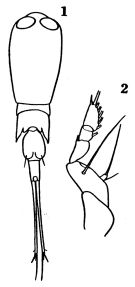 issued from : O. Tanaka in J. Fac. Agricult. Kyushu Univ., 1957, 11 (1). [Pl.6, Figs.1-2]. Male (from Japanese waters): 1, habitus (dorsal); 2, P4. Nota: The abdominal segments and furca in the proportional lengths 25:28:57.
|
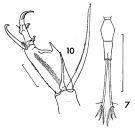 issued from : F.C. Ramirez in Revta Mus. La Plata, Seccion Zool., 1971, XI. [Lam.III, Figs.7, 10]. Female (from off Mar del Plata): 7, urosome (dorsal); 10, A2. Scale bars in mm: 1 (7); 0.1 (10).
|
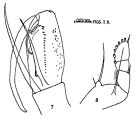 issued from : J. Corral Estrada in Tesis Doct., Univ. Madrid, A-129, Sec. Biologicas, 1970. [Lam.61, fig.7-8]. Male (from Canarias Is.): 7, A2; 8, P4.
|
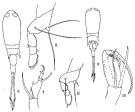 issued from : Q.-c Chen & S.-z. Zhang & C.-s. Zhu in Studia Marina Sinica, 1974, 9. [Pl.16, Figs.6-11]. Female (from China Seas): 6, habitus (dorsal); 7, A2; 8, P4. Male: 9, habitus (dorsal); 10, A2; 11, P4.
|
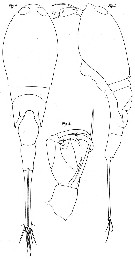 issued from : M. Dahl in Ergebnisse der Plankton-Expedition der Humboldt-Stiftung. Bd II, G. f1. I. Die Corycaeinen 1912. [Taf.VII, Figs.4, 5, 8]. Female: 4, habitus (dorsal); 5, idem (lateral left side); 8, A2.
|
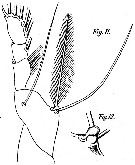 issued from : M. Dahl in Ergebnisse der Plankton-Expedition der Humboldt-Stiftung. Bd II, G. f1. I. Die Corycaeinen 1912. [Taf.VII, Figs.11, 12]. Female: 11, P4; 12, P4 (base of setae).
|
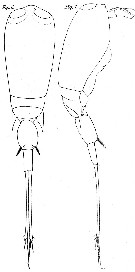 issued from : M. Dahl in Ergebnisse der Plankton-Expedition der Humboldt-Stiftung. Bd II, G. f1. I. Die Corycaeinen 1912. [Taf.VII, Figs.6, 7]. Male: 6, habitus (dorsal); 7, idem (lateral right side).
|
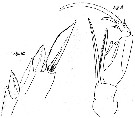 issued from : M. Dahl in Ergebnisse der Plankton-Expedition der Humboldt-Stiftung. Bd II, G. f1. I. Die Corycaeinen 1912. [Taf.VII, Figs.9, 10]. Male: 9, A2; 10, terminal part of exopod of P1.
|
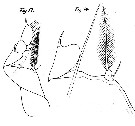 issued from : M. Dahl in Ergebnisse der Plankton-Expedition der Humboldt-Stiftung. Bd II, G. f1. I. Die Corycaeinen 1912. [Taf.VII, Figs.13, 14]. Male: 13, P4; 14, distal margin of basippod 2 of P4.
|
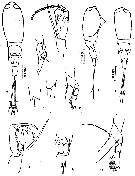 issued from : Z. Zheng, S. Li, S.J. Li & B. Chen inMarine planktonic copepods in Chinese waters. Shanghai Sc. Techn. Press, 1982 [p.141, Fig.88]. Female: a, habitus (dorsal); b-c, anal segment (dorsal and lateral, respectively); d, A2; e, P4. Male: f-g, habitus (dorsal and lateral, respectively); h, urosome (dorsal); i, idem (lateral, right side); j, A2; k, P4.
|
 issued from : F. Cervigon iin Mem. Soc. Cienc. nat. La Salle, 1964, 24 (68). [p.177, Lam.9]. As Urocorycaeus lautus. Female (from Venezuela): 1, habitus (dorsal); 2, abdomen (dorsal); 3, habitus (lateral); 4, abdomen (lateral); 5, portion distal of caudal ramus and setae; 6, A2; 7, P4. Nota: Lengths ratio genital , anal segments and caudal rami 25:25:50 and 23:23:53.
|
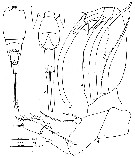 issued from : F. Cervigon iin Mem. Soc. Cienc. nat. La Salle, 1964, 24 (68). [p.178, Lam.10]. As Urocorycaeus lautus. Male: 1, habitus (dorsal); 2, abdomen (dorsal); 3, A2; 4, P4. Nota: Lengths ratio genital , anal segments and caudal rami 27:16:57 and 24:18:58.
|
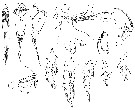 issued from : M. Rose in Result. Camp. Scient. Prince Albert Ier, Monaco, 1929, 78. [Pl. V, Figs.11]. Male (from temperate N Atlantic; individual from 2 mm): D, habitus (dorsal); L, idem (lateral); Ab + F, urosome (ventral); A1; A2; Mxp (as Mxp2); P1 to P4.
|
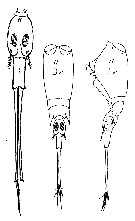 issued from : M. Rose in Result. Camp. Scient. Prince Albert Ier, Monaco, 1929, 78. [Pl. V, Figs.11]. Male (from individual body size 2.5 mm): D, habitus (dorsal); L, idem (lateral); Ab + F, urosome (ventral).
|
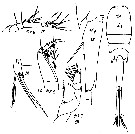 issued from : M. Rose in Result. Camp. Scient. Prince Albert Ier, Monaco, 1929, 78. [Pl. V, Figs.12]. As Mimocorycella Pestai>. Copepodite female: d, habitus (dorsam); ab, urosome (lateral); f, distal part of caudal ramus; A1; A2; P4.
|
 issued from : M. Rose in Result. Camp. Scient. Prince Albert Ier, Monaco, 1929, 78. [Pl. V, Figs.12]. As Mimocorycella Pestai>. Copepodite female: D, habitus (dorsal); L, idem (lateral); AF, urosome (ventral); SF, distal part of caudal ramus and terminal setae (ventral); a.f., distal part of caudal ramus (from side); s.f., detail of spinulous caudal seta; A1; A2; sA2, one of terminal claw of A2; d A2, inner tooth on 2nd segment of basipod of A2; Mx2 (as Mxp1); Mxp (as Mxp2).
|
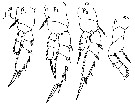 issued from : M. Rose in Result. Camp. Scient. Prince Albert Ier, Monaco, 1929, 78. [Pl. V, Figs.12]. As Mimocorycella Pestai>. Copepodite): P1 to P4
|
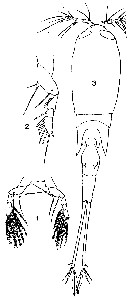 issued from : T. Mori in The Pelagic copepoda from the neighbouring waters of Japan, 1937 (1964). [Pl. 72, Figs.1, 3, 6]. Female: 1, P4; 3, habitus (dorsal); 6, A2.
|
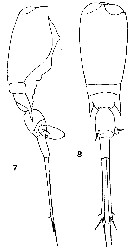 issued from : T. Mori in The Pelagic copepoda from the neighbouring waters of Japan, 1937 (1964). [Pl. 72, Figs.7-8]. Male: habitus (lateral and dorsal, respectively).
|
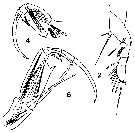 issued from : T. Mori in The Pelagic copepoda from the neighbouring waters of Japan, 1937 (1964). [Pl. 72, Figs.2, 4, 5]. Male: 2, P4; 4, Mxp; 5, A2.
|
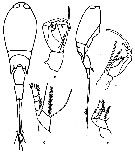 Issued from : F. Vives & A.A. Shmeleva in Fauna Iberica, 2010, 33. [p.244, Fig.114]. After Dahl, 1912. Female: A, habitus (dorsal); B, A2; C, P4. Nota: Caudal rami slightly longer than abdomen. Male: D, habitus (lateral); E, A2; F, P4. Nota: Caudal rami less than 1.5 times longer than abdomen.
| | | | | Compl. Ref.: | | | Rose, 1931 a (p.257); Wilson, 1942 a (p.181); 1950 (p.194); Yamazi, 1958 (p.155, Rem.); Björnberg, 1963 (p.85, Rem.); Furuhashi, 1966 a (p.295, vertical distribution in Kuroshio region, Table 9); Mazza, 1966 (p.74); 1967 (p.326); Pavlova, 1966 (p.45); Deevey, 1971 (p.224); Meenakshikunjamma, 1974 (p.772: biogéo.); Deevey & Brooks, 1977 (p.156, tab.2, Station "S"); Vives, 1982 (p.296); Kovalev & Shmeleva, 1982 (p.86, as latus : 2nd citation); Tremblay & Anderson, 1984 (p.7, Rem. ); Guangshan & Honglin, 1984 (p.118, tab.); Brinton & al., 1986 (p.228, Table 1); M. Lefèvre, 1986 (p.33, 40); Jimenez-Perez & Lara-Lara, 1988; Lozano Soldevilla & al., 1988 (p.61); Hernandez-Trujillo, 1989 a (tab.1); Cervantes-Duarte & Hernandez-Trujillo, 1989 (tab.3); Hernandez-Trujillo, 1991 (1993) (tab.I); Palomares Garcia & Vera, 1995 (tab.1); Shih & Young, 1995 (p.76); Suarez-Morales & Gasca, 1997 (p.1525); Alvarez-Cadena & al., 1998 (t.1,2,3,4); Suarez-Morales, 1998 (p.345, Table 1); Suarez-Morales & Gasca, 1998 a (p.112); Noda & al., 1998 (p.55, Table 3, occurrence); Lavaniegos & Gonzalez-Navarro, 1999 (p.239, Appx.1); Lapernat, 2000 (tabl.3, 4); El-Sherif & Aboul Ezz, 2000 (p.61, Table 3: occurrence); Suarez-Morales & Gasca, 2000 (1247, tab.1); Alvarez-Silva & Gomez-Aguirre, 2000 (p.163: tab.2); Lopez-Salgado & al., 2000 (tab.1); Lo & al., 2001 (1139, tab.I); Rezai & al., 2004 (p.490, tab.2); Lo & al.*, 2004 (p.218, tab.1, fig.6); Lo & al., 2004 (p.468, tab.2); Lan & al., 2004 (p.332, tab.1); Lo & al., 2004 (p.89, tab.1); Hwang & al., 2006 (p.943, tabl. I); Lopez-Ibarra & Palomares-Garcia, 2006 (p.63, Tabl. 1, seasonal abundance vs El-Niño); Dias & Araujo, 2006 (p.82, Rem., chart); Khelifi-Touhami & al., 2007 (p.327, Table 1); Hwang & al., 2007 (p.25); Tseng L.-C. & al., 2008 (p.153, fig.5, Table 2, occurrence vs geographic distribution, indicator species); Ayon & al., 2008 (p.238, Table 4: Peruvian samples); Magalhaes & al., 2009 (p.187, Table 1, %); Pagano, 2009 (p.116); C.E. Morales & al., 2010 (p.158, Table 1); Williamson & McGowan, 2010 (p.273, Table 3, Pacific central gyres: N and S); Hernandez-Trujillo & al., 2010 (p.913, Table 2); Hidalgo & al., 2010 (p.2089, fig.4, Table 2, cluster analysis); Dias & al., 2010 (p.230, Table 1); Medellin-Mora & Navas S., 2010 (p.265, Tab. 2); W.-B. Chang & al., 2010 (p.735, Table 2, abundance); Hsiao S.H. & al., 2011 (p.475, Appendix I); Kâ & Hwang, 2011 (p.155, Table 3: occurrence %); Tseng L.-C. & al., 2011 (p.47, Table 2, occurrences vs mesh sizes); Maiphae & Sa-ardrit, 2011 (p.641, Table 2); Andersen N.G. & al., 2011 (p.71, Fig.3: abundance); Selifonova, 2011 a (p.77, Table 1, alien species in Black Sea); in CalCOFI regional list (MDO, Nov. 2013; M. Ohman, comm. pers.); Tseng & al., 2013 (p.507, seasonal abundance); Lidvanov & al., 2013 (p.290, Table 2, % composition); Hwang & al., 2014 (p.43, Appendix A: seasonal abundance); Bonecker & a., 2014 (p.445, Table II: frequency, horizontal & vertical distributions); Marquez-Rojas & al., 2014 (p.7, Rem., %); Dias & al., 2015 (p.483, Table 2, abundance, biomass, production); Zakaria & al., 2016 (p.1, Table 1, Rem.); Palomares-Garcia & al., 2018 (p.178, Table 1: occurrence) | | | | NZ: | 18 | | |
|
Distribution map of Corycaeus (Urocorycaeus) lautus by geographical zones
|
| | | | | | | | | | | |  issued from : P.P. Meenakshikunjamma in J. mar. biol. Ass. India, 1974, 16 (3). [p.772, Fig.3]. issued from : P.P. Meenakshikunjamma in J. mar. biol. Ass. India, 1974, 16 (3). [p.772, Fig.3].
Distribution of Corycaeus (Urocorycaeus) lautusr in the Indian Ocean. |
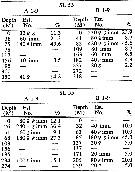 issued from : H.B. Owre & M. Foyo in Fauna Caribaea, 1, Crustacea, 1: Copepoda. Copepods of the Florida Current. 1967. [p.123, Table 65]. issued from : H.B. Owre & M. Foyo in Fauna Caribaea, 1, Crustacea, 1: Copepoda. Copepods of the Florida Current. 1967. [p.123, Table 65].
Vertical distribution of Corycaeus (U.) lautus at the ''40-Mile Station'' in the Florida Current ( E Miami: ± 25°35'N, 79°27'W; depth 738 m).
SL 53: 18 V 1958; SL 55: 21 VII 1958. A: during midday; B: during midnight.
imm = copepodites. |
| | | | Loc: | | | G. of Guinea, off NW Cape Verde Is., off Morocco-Mauritania, Canary Is., off Madeira, Portugal, off Azores (S & W), Patagonia, Brazil (Rio de Janeiro, Campos Basin, off Vitoria-Cabo de Sao Tomé, off Macaé, Curuça estuary), Caribbean, Caribbean Colombia, Venezuela, Cariaco Gulf, Bahia de Mochima, Yucatan, Caribbean Sea, G. of Mexico, Cuba, Florida, Sargasso Sea, off Bermuda (Station "S"), Flemish Cap, W Ireland, Ibero-moroccan Bay, Medit. (Algiers, El Kala shelf, Marseille, Aegean Sea, Black Sea, W Egyptian coast), Red Sea (Sharm El-Sheikh), Rodrigues Is., Indian, Straits of Malacca, Philippines, China Seas (East China Sea, South China Sea), Taiwan (E, S, SW, Tapong Bay, NW, N: Mienhua Canyon, NE), S Korea, Japan, Kuchinoerabus Is., Tanabe Bay, Kamchatka, Bering Sea, Pacif. (W equatorial), Australia (Great Barrier, New South Wales), New Caledonia, N New Zealand, I. Moorea (lagon), off Hawaii, Pacif. (E equatorial), Pacific (central gyres: N and S), Clipperton Is., W & S BaJa California (Bahia Magdalena, La Paz), Gulf of California, Acapulco Bay, Peru, off Chile, Chile (N-S, Concepcion) | | | | N: | 133 | | | | Lg.: | | | (34) F: 2,84; M: 2,22-2,16; (35) [Atlant.N] F: 2,85; M: 2,3; [N-Z] F: 2,94; M: 2,5; (91) F: ± 2,7; M: ± 2,2; (104) F: 2,45; M: 1,45; (107) M: 2,32-2,29; (109) F: 2,82; M: 2,12; (180) M: 2,51; (666) F: 2,713-2,7; M: 2,36-2,09; (667) F: 3,05-2,65; M: 2,55-2,2; (668) F: 2,89-2,72; M: 2,32-2,28; (669) F: 2,75; M: 2,15; (866) F: 2,61; (991) F: 2,29-3,05; M: 2,09-2,36; (1023) F: 2,73-2,94; M: 2,2-2,7; {F: 2,29-3,05; M: 1,45-2,55} | | | | Rem.: | epi-mesopelagic. Overall Depth Range in Saegasso Sea: 0-1000 m (Deevey & Brooks, 1977, Station "S"). 0-217 m at Station T-1 (E Tori Is., E middle Japan) from Furuhashi (1966 a).
The remark put forward by Rose (1931, 1931 a) about difficulties for this species to survive in the Eastern Mediterranean basin seems to be confirmed in 2004.
For us, this species is noted for the first time in the N Red Sea (Sharm El-Sheikh) by El-Sherif & Aboul Ezz (2000, p.72);
For Boxshall & Halsey (2004, p.491) the subgenus (Dahl, 1912) is considered as full generic status pending phylogenetic revision of the whole family at the generic level.
See in DVP Conway & al., 2003 (version 1) | | | Last update : 13/11/2020 | |
|
|
 Any use of this site for a publication will be mentioned with the following reference : Any use of this site for a publication will be mentioned with the following reference :
Razouls C., Desreumaux N., Kouwenberg J. and de Bovée F., 2005-2025. - Biodiversity of Marine Planktonic Copepods (morphology, geographical distribution and biological data). Sorbonne University, CNRS. Available at http://copepodes.obs-banyuls.fr/en [Accessed December 13, 2025] © copyright 2005-2025 Sorbonne University, CNRS
|
|
 |
 |


























